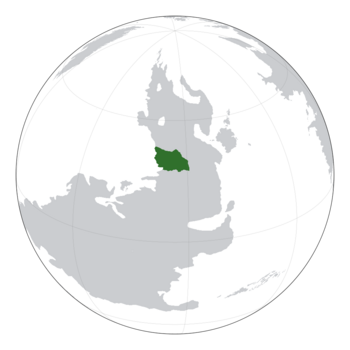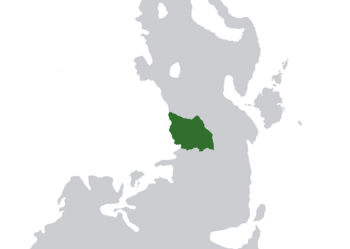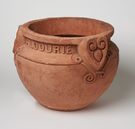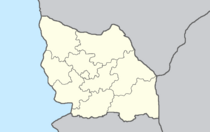Hapatmitas
Commonwealth of Hapatmitas Co-fhlaitheis Hapatmitas | |
|---|---|
Motto: Adhartas, dìlseachd, aonachd. "Progress, loyalty, unity." | |
Location of Hapatmitas (dark green) | |
| Capital | Donideann |
| Largest city | Sturgeon |
| Official languages | Cantuath |
| Ethnic groups | 89.2% Hapat 2.6% Paleocacherian 8.2% Other |
| Religion | 56.8% Christianity 28.7% Unaffiliated 6.1% Clovity 8.4% Other |
| Demonym(s) | Hapatmitasian |
| Government | Unitary parliamentary republic |
| Ewan Thorcaill | |
| Doug Macintosh | |
| Legislature | Tiomnaidh |
| Senate | |
| National Assembly | |
| Formation | |
• Canton created | TBD |
• Formation of the Rinnfriu Confederation | TBD |
• Principality established | TBD |
• Coronation of Robert I | TBD |
• 1822 constitution adopted | TBD |
• Establishment of the republic | TBD |
| TBD | |
| 1 July 1972 | |
| Area | |
• Total | 274,159 sq mi (710,070 km2) (41st) |
| Population | |
• 2020 census | |
• Density | 142/sq mi (54.8/km2) |
| GDP (nominal) | 2023 estimate |
• Total | ₵1.36 trillion (18th) |
• Per capita | ₵34,936 (15th) |
| HDI (2021) | very high · 11th |
| Currency | Hapatmitasian pìoban (₴) (HPB) |
| Time zone | AMT+12 (Donideann Standard Time) |
| Driving side | right |
| Calling code | +403 |
Hapatmitas (Cantuath: ![]() xapʌtmi:tæːz), officially the Commonwealth of Hapatmitas (Cantuath: Co-fhlaitheis Hapatmitas), is a country located in northern Ostlandet. The country is bordered by Paleocacher to the north and the Acernis Ocean to the west. It has an area that spans 274,159 sq mi (710,070 km2) that is divided into ten provinces, making Hapatmitas the 41st largest country in the world. As of 2023, the country has a population of 39 million. Hapatmitas' capital city is Donideann and its most populous city is Sturgeon, housing nearly 9 million residents. Other major cities including Peairtchu, Boghmor, Crubagath, Inchmarlo, and Banchar.
xapʌtmi:tæːz), officially the Commonwealth of Hapatmitas (Cantuath: Co-fhlaitheis Hapatmitas), is a country located in northern Ostlandet. The country is bordered by Paleocacher to the north and the Acernis Ocean to the west. It has an area that spans 274,159 sq mi (710,070 km2) that is divided into ten provinces, making Hapatmitas the 41st largest country in the world. As of 2023, the country has a population of 39 million. Hapatmitas' capital city is Donideann and its most populous city is Sturgeon, housing nearly 9 million residents. Other major cities including Peairtchu, Boghmor, Crubagath, Inchmarlo, and Banchar.
The area of Hapatmitas has been inhabited for 3,000 years. The first Hapats, along with various other groups, migrated to this area from Paleocacher at the start of the 8th century. These groups were organised into cantons that contended for the natural resources in these river settlement regions. Many of them formed cantonal alliances that pushed back foreign invaders and rival alliances. In 934, the cantons located on the Rinnfriu River and its tributaries united to form a military and economic alliance in response to their northern counterpart on the Forth River. After the collapse of the confederal system in 1242, Hapatmitas absorbed many neighboring states after a series of treaties and formally became the Principality of Hapatmitas. The principality focused on the growth of the state, denoted by territorial and economic achievements.
After a series of failed power struggles due to the extinction of the Chalanais dynasty, Robert Stiubhart, a far cousin once removed of the last prince Donald VIII, was elected and acceded to become the next prince in 1434 by a temporary nobles' court. However, upon his accession, Robert declared himself and his descendants the King of Hapatmitas instead. His reign marked the beginning of Stiubhart rule in the country. Throughout the timeline of the Kingdom, Hapatmitas exponentially grew in military and technological powers. The country fostered a robust trade economy with other countries, establishing many charter ports across the coasts of Ostlandet. In 1822, Alasdair VII relinquished his absolute power to his privy council as a compromise to the Revolt of 1822. The privy council eventually evolved into a lawmaking assembly independent of the king's jurisdiction; the king was also now styled as King of the Hapats rather than King of Hapatmitas. The monarchy was abolished in 1924 following the abdication of James VIII. A republic was established in its place; however, corrupt and monarchist-aligned governments often interchanged between elections. As a result, reformist-aligned militias unified and began insurgencies across the country, culminating into civil war in 1947 which the reformists won. They established the Commonwealth, ratifying a new constitution in 1950.
Over seventy years, Hapatmitas unwaveringly advanced its economy, military, technology, and government. The pharmaceutical and banking sectors grew tremendously, expanding the Hapatmitasian influence across the Acernis Ocean and Ostlandet. Hapatmitasian infrastructure was also mass-developed across Peannish and the highlands region, connecting the country's cities' network. The military invested in new military technology and reorganised the command structure which refortified the Hapatmitasian military response command and technology. Hapatmitas also deeply expanded its foreign relations, building dozens of embassies across Terraconserva. The legislature also went under major restructuring changes a total of eight times since 2002, and the process of democratic reform within the chamber also greatly improved suffrage throughout Hapatmitas.
Hapatmitas is a member of the Ostlandet Union, Prosperity of 7, and Terraconserva Council of Nations. The country currently follows an active foreign policy while restraining itself from directly intervening in major conflicts. More recently, in the military intervention in Shaoyu, Hapatmitas supported the Ostlandet Union task force for intervention with material and diplomatic means. The country has historically been neutral in international conflicts but has advanced towards closer foreign relations after its civil war. The country also has a strict system for education, healthcare, and workers' rights in part due to the post-authoritarian growth. As of 2023, Hapatmitas' diverse economy is currently the 18th largest by nominal gross domestic product (GDP) in Terraconserva; the country also has a very high Human Development Index; and has a score of 8.83 in the Global Democracy Index, making it the second-most democratic country on Ostlandet and one of the most democratic countries in the world.
Contents
Etymology
The name Hapatmitas derives from the name of the predominant ethnicity in the country, which is the Hapats, and the Old Cantuath word for land, which sounds like mighta in the Hapat dialect. During the evolution into New Cantuath, it eventually became mita instead. The origin of the name Hapat is largely unknown but some historians consider it named after Hapator, a pagan god of rain that the Hapats worshipped during the time of settlement.
History
Proto-civilizations and settlement (to c. 900)
Historians and archaeologists believe that Hapatmitas has been inhabited for nearly 3,000 years. As part of the last few minor migrations from Ecros to Ostlandet, settlers usually arrived on large boats. The first tribal civilizations started growing in c. 400 BC. Mass plantations of wheat, barley, and various root tuber vegetables across the Rinnfriu and Forth rivers were created which grew the northern and southern regions of Hapatmitas. These settlements were often led by a group of people with expertise in various occupations: farmers, ironsmiths, and builders. Farmers comprised of majority of these populations, often followed by builders and then ironsmiths. Other smaller groups of settlers moved inland towards the Hapatmitasian highlands and farmed using hill terrace methods that were effective in utilizing the mountain groundwater. Many civilizations also advanced in farming technology, including the plow first introduced to Hapatmitasian civilizations in 330 BC.
Infighting between the tribes started around 40 AD. Their farms became intertwined with one another due to unexpected growth and, as a result, farmers began fighting each other over the amount of land each one owned. Tribal leaders often refused to negotiate and went to war, devastating the food sources of the river civilizations and ending many tribes. In other cases, tribes formed temporary alliances to attack a common enemy. These alliances were the only means of cooperation and peace during this time. Many other skirmishes alike would follow through the rest of the prehistoric era of Hapatmitas.
The first major civilization in Hapatmitas was the Celiac Empire. Celia emerged around the 3rd century in present-day Gaillimhe. The Celiacs were renowned for being nomadic, having a culture that strongly relied on the use of horses. As skillful farmers and merchants joined together at the helm, the civilization became largely economical. Celiacs also rapidly militarized and used their military power to invade surrounding neighbors. The civilization relied on local governors and shared farming communes to protect its territory. The empire, at its height, expanded as far as past the highlands region. The civilization collapsed in c. 500 AD after a series of northern raids by Lithorics, which succeeded the Celiac civilization, combined with a declining military and economy.
After successfully invading Celia, Lithor began enforcing its rule over its predecessor's territory. The remaining Celiacs were put into slavery by Lithoric nobles and were often put to work building massive statues worshipping Lithoric kings. This process of suppression eventually wiped away the Celiac ethnic group. Lithor was radical in its military, often dubbing raids and campaigns as "the will of the gods." The promotion of literacy was also suppressed and those capable of expressing art were forced to create large hieroglyphics of pagan gods and past Lithoric kings. The kingdom fell at the end of the 7th century due to instability.
At the start of the 8th century, the first migrations from Paleocacher to Hapatmitas began. Emigrants that settled in modern-day Chiarain often migrated on foot while others migrated by horse and wagon. The Hapats settled in the east of modern-day Gaillimhe. On the Rinnfriu and Forth rivers, emigrants began even larger plantations than those during the prehistoric civilizations, even setting up villages that formed unofficial cantons. These cantons often joined together to form confederal associations dependent on the rivers. Over the century, the confederal associations across Hapatmitas began to transition into caste kingdoms. Kings were often elected to direct the direction of the state's food supply, economy, and defense. This system was customized to each association, with some cultural customs sometimes also being installed into government. However, the kings’ decrees often interfered with each other which unleashed many bloody wars. Infighting continued until the end of the 9th century.
Rinnfriu Confederation (934–1242)
Principality of Hapatmitas (1242–1434)
Kingdom of Hapatmitas (1434–1924)
Republic of Hapatmitas (1924–1950)
Hapatmitasian Civil War (1947–1950)
Modern Hapatmitas (1950–present)
Geography
Climate
Environment
Urbanization
Government and politics
Hapatmitas is a unitary parliamentary republic. National legislative power is vested into the bicameral Tiomnaidh, which is comprised of the upper Senate and the lower National Assembly. Members of the lower house are elected through direct elections using the mixed-member proportional representation system with multi-member seats, while members of the upper house are elected the same way but with the open-list proportional representation system. The Hapatmitasian political system operates under a framework laid out in the 1950 constitution. Constitutional amendments generally require a two-thirds majority of the legislature in joint session; the fundamental principles of the constitution are inscribed permanently. In particular, the MMP representation electoral system was a recent amendment to better suffix a proportionate representation of the growing Hapatmitasian population in the national legislature.
Under the parliamentary system, the head of state is the President of Hapatmitas, currently Ewan Thorcaill, who serves primarily at a ceremonial level. The President is elected by the Tiomnaidh in a joint session for a six-year term. The Prime Minister, currently Doug Macintosh, is the head of government, nominally appointed by the president; the Prime Minister is also concurrently the leader of the largest party in the National Assembly and is responsible for administering the session's business. Since the president holds most ceremonial responsibilities, such as the dissolution of the Tiomnaidh or the appointing of civil servants and judges, the prime minister makes recommendations to the president instead of directly appointing individuals into positions and services. The negotiation and ratification of international agreements, however, lays within the National Assembly, which assigns the responsibility to the prime minister. The commander-in-chief of the armed forces is the president, although the office is purely ceremonial and actual duties lie within the Chief of the Defence Staff.
Historically, conservative factions were the primarily dominant political force in Hapatmitas. However, after the end of the civil war in 1950, politics in Hapatmitas consisted of three politically opposing groups - moderate conservatives, liberal and social democrats, and other minority parties. Today, Hapatmitasian politics mainly consists of two political rivals - the National Democratic Union and the Social Democratic Party.
Administrative divisions
Hapatmitas, with a total area of 274,159 square miles (710,070 square kilometres) is divided into ten provinces (Cantuath: mòr-roinn). The administrative divisions are organised into four different levels - the central government, first-level divisions, second-level divisions, and third-level divisions. Provinces are first-level divisions; municipalities (bailtean-mòra) and counties (siorrachdan) are second-level divisions; and districts (sgìrean) and townships (bailtean) are third-level divisions. Public and private agencies often refer to these subdivisions for statistical use.
The current local government system was created on 10 January 1964 to merge provinces and consolidate more power into local government. Before 1964, provinces with large populations often were given a higher level than rural provinces; as a result, urban provinces were given more financial sustainability. After the system was established, equal power leveling was created to optimise "provincial potential" while maintaining the unitary status. Today, provinces are governed by directly-elected provincial councils every five years (at the same time as the co-Presidents), with a distinct possibility of recall referendum and elections occurring more as a result of the term length; the most recent Hapatmitasian local elections were held on DATE. Public agencies, law enforcement, and other local institutions often use unified municipal boundaries to administer their duties.
Foreign relations
Hapatmitas is currently a member of the Ostlandet Union and the Terraconserva Council of Nations. Because of its historic neutrality, Hapatmitas has good relations with most countries across Terraconserva, with closer cultural ties to Gallaetic countries such as Paleocacher and its historic influence from Montcrabe. It also possesses membership in the P7 which has promoted deep economic ties with countries in other continents.
Because of its positive relations, Hapatmitas is a trading partner to several economically influential countries. It has often performed joint military operations, economic initiatives, and other forms of supranational activities that have grown the country. Joint economic ventures in corporations such as Robasdan has developed the robust Hapatmitasian economy.
Military

Hapatmitas' military (Feachdan Armaichte Hapatmitasian; FAH) is organised into the Arm (Army and ground special forces), Cabhlach (Navy), Feachd Adhair (Air Force), and the Maoir-chladaich (Coast Guard). These service branches formally serve as the collective armed forces of Hapatmitas. Since 1982, the expenditure for the military has always been the highest in the national budget. After the military conflict regarding Akvatika (Shaoyu) Island in September 2023, the government pledged an additional ₴1 billion to defence in the next fiscal year.
As of December 2023, the FAH has a strength of 53,000 active soldiers and 340,000 reservists. Reservists are available to the armed forces and participate in defence exercises and deployments abroad. Since 2000, the armed forces has maintained voluntary service. Since 1996, women have been granted the right to serve in all functions of military service without restriction; military ethics codes were also updated in regards to religion and gender. Hapatmitas, despite its industrial state, does not produce any major domestic arms and hence imports a lot of arms.
The role of commander-in-chief is held by the President. However, in actual fact, the FAH is commanded by the Chief of the Defence Staff, with deputisation from the Minister of Defence. In the Constitution of Hapatmitas, the role of the FAH during wartime is defined to be defensive which includes "the defence of internal security, aligned interests, and the protection of Hapatmitasian borders and sovereignty." A 2004 ruling by the Constitutional Court also deemed the FAH responsible for "crisis reaction, conflict prevention, and resolution of disputes." Despite the defensive doctrine, the armed forces still maintain a neutral stance at home and does not keep any foreign peacekeeping soldiers abroad as of 2023.
Security, law enforcement and emergency services
Law enforcement in Hapatmitas is performed by multiple agencies. All law enforcement agencies are nationally administered and regulated by the Ministry of the Interior. Despite being a separate entity from the Ministry of the Interior, the Armailleas forms the national police forces of Hapatmitas with the National Police. In the regions and municipalities, the National Police employs a prefectural system to regionalise policing. Specialised law enforcement agencies, such as the Border Services Agency, are still administrated and regulated by the Ministry of the Interior. Private security firms are allowed to operate in Hapatmitas but they do not have legal authority or jurisdiction to arrest or detain suspected individuals. The Armailleas and the National Police often perform joint patrols or operations in municipalities.
Internal security is currently jointly managed by the Ministry of the Interior (Ministrealachd an Taobh a-staigh; MTA), the National Intelligence Service (Seirbheis Fiosrachaidh Nàiseanta; SFN), and the Military Intelligence Directorate (Buidheann-stiùiridh Fiosrachaidh Armailteach; BSFA). The MTA is responsible for administering lower agencies involved with civil and minor domestic security threats; the SFN is the chief domestic agency responsible for identifying domestic threats to national security and safeguarding national security by task forces; the BSFA is the foreign agency instrumental in gathering intelligence abroad concerning internal security and investigating foreign breaches involving Hapatmitasian national security.
Emergency services in Hapatmitas consist of emergency medical services, search and rescue units, and fire services. Emergency medical services are generally operated by municipalities and other types of cities but are all part of the regional agency responsible for emergency medical response. Search and rescue units in Hapatmitas are diversified between special units of a local police force and/or search-and-rescue units deriving from the Hapatmitasian Armed Forces. Fire services are administrated by grouped provincial departments, especially in densely populated regions such as Gaillimhe; in larger provinces such as those in the region of Paislig agus Chluaidh possess their department but are sometimes provided less funding than urban departments.
Economy
Overview
Agriculture and mining
Manufacturing
Technology and science
Infrastructure and transport
Demographics
Ethnicities
Languages
Religion
Education
Health
Culture
Hapat culture has been strongly associated with the faith in Christianity. In part due to the Montcrabin Catholic missionaries that arrived in Hapatmitas during the 13th century, the culture of Hapatmitas has been largely surrounded God and the belief in God's intuition in granting great harvests and prosperity to professions. The belief in individualism in Hapatmitas advanced the population's performance in literacy and art. However, despite individualistic ideals, Hapats often encourage each other to participate in governance and part-altruism to avoid strife with God. These combined faiths created a society based on merit and performance rather than aristocracy and hierarchy. Hapats in the faith of Clovity empathized with the Christian ideals and incorporated these beliefs as well. In a 2016 government survey, 82% of the Christian population believed in cooperative ideals of individualism and collectivism.
The expression of culture expanded upon the start of the Principality. Festivals, art, and architecture became popular during peacetime. The art of scriptures also became enrooted into Hapat culture, most notably in calligraphy and records. Hapats had a closer expertise, however, in physical refinery which included the occupations of blacksmiths, hunters, miners, and farmers. Architecture in Hapatmitas is strongly influenced by prehistoric civilizations as well as from foreign countries, such as Montcrabe. Linguistically, Cantuath is the commonplace language in Hapatmitas because of its official status. However, other languages including LANGUAGE 1 and LANGUAGE 2 are used by minorities in border regions of the country.
Television and media
Music
Hapat music is a significant aspect of the nation's culture, incorporating both traditional and modern influences. The most famous traditional Hapat instrument is the Gaidhealtachd bagpipe, a woodwind instrument consisting of three drones and a melody pipe fed continuously by a reservoir of air in a bag. As opposed to (Paleocacherian bagpipe), the Gaidhealtachd bagpipe's parts, such as the chanter reed and bag, are made out of native Hapatmitasian materials. In military bands, the bagpipe is usually played along with various types of percussion and brass instruments, with players showcasing traditional Hapat dresses. Pipe music is also featured in holiday celebrations, funerals, weddings, military parades, and other events. During the monarchist era of Hapatmitas, bagpipes were most commonly associated with the presence of an emperor, especially at their coronations. In some military regiments, a pipe band may solely consist of bagpipe players. While the bagpipe is extremely popular, other brass instruments are also equally played as often including the trumpet and the tuba.
Several domestic and international award shows and festivals recognise musical talent in Hapatmitas. Some of the domestic shows and festivals include the Connection Festival Sturgeon, Hapat Music Awards, Grand Music of Hapatmitas, and the All-Hapatmitas Bagpipe Competition. Additionally, the promotion of string arts in Hapatmitas has excessively grown since a 2004 government initiative. Today, the International MacRaghnaill Competition is renowned for hosting quadrennial classical music competitions for ages between 16 and 32 years old - it is considered one of the easiest yet rigorous ways to earn a scholarship in Hapatmitas.
Architecture
Sports
Public holidays
Currently, there are 13 national public holidays in Hapatmitas. Some holidays are referred to as bank holidays, which most government agencies and banks close on as well. The government requires employers to function their business as a non-working day or to pay workers overtime if they work on that holiday. The government recognizes other unofficial holidays but does not recognize them as non-working days. Regional holidays of culture or history may be declared with recognition if they pass the regional council. For instance, three other bank holidays are recognized for the autumn, winter, and springtime seasons but vary by region; the only bank holidays every region observes on the same day are on 4 June, 4 August, and 19 August.

The thirteen national public holidays are:
| Date(s) observed | English name | Cantuath name | Remarks |
|---|---|---|---|
| 1 January | New Year's Day | Là na Bliadhn' Ùire | Celebrates the start of a new calendar year |
| 2 January | 2 January Day | Dàrna latha den Fhaoilleach | Official bank holiday; created in 2006 to extend the New Year's holiday |
| moveable | Good Friday | Dihaoine na Càisge | Commemorates of the crucifixion of Jesus Christ |
| moveable | Easter Sunday | Didòmhnaich na Càisge | Commemorates of the resurrection of Jesus Christ from the dead |
| 1 May | Labour Day | Là Làbarach | Celebrates the achievements of workers |
| 4 June | Summer Bank Holiday | Ceathramh latha den Ògmhios | An official national bank holiday for the Summer season |
| 1 July | National Day | Latha Nàiseanta | Celebrates the anniversary of the proclamation of the Commonwealth |
| 6 July | Civil Victory Day | Latha Buaidh Shìobhalta | Celebrates the anniversary of the end of the Hapatmitasian Civil War |
| 4 August | Opening Day | Latha Fosglaidh | An official national bank holiday; concurrent with the opening of Parliament and observed only every four years |
| 19 August | Remembrance Day | Latha Cuimhneachaidh | An official national bank holiday; commemorates the achievements of fallen soldiers |
| 4 September | Foundation Day | Latha Bunait | Celebrates the anniversary of the foundation of the first consolidated Hapatmitasian state |
| 30 November | Saint Duncan's Day | Latha Naomh Donnachadh | The feast day of Saint Duncan, patron saint of Hapatmitas |
| 25 December | Christmas Day | Latha na Nollaige | Commemorates the birth of Jesus Christ |












